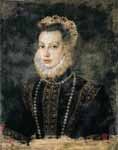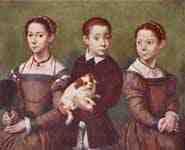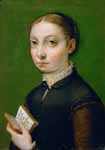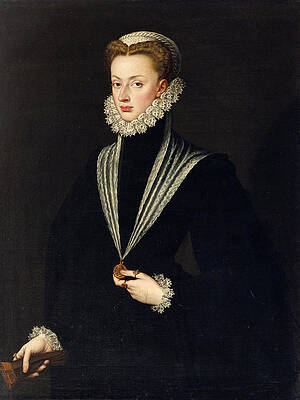Sofonisba Anguissola
Paintings
Portrait of a Young Lady
Portrait of Archduchess Johanna of Austria

Isabella of Valois (1545-1568), wife of Philip II, King of Spain


Sofonisba Anguissola (also spelled Anguisciola) (c. 1532 – 16 November 1625) was an Italian Renaissance painter born in Cremona. She received a well-rounded education that included the fine arts, and her apprenticeship with local painters set a precedent for women to be accepted as students of art. As a young woman, Anguissola traveled to Rome where she was introduced to Michelangelo, who immediately recognized her talent, and to Milan, where she painted the Duke of Alba.
Sofonisba Anguissola by Anthony van Dyck
Elizabeth of Valois, the queen of Philip II of Spain, was a keen amateur painter, and Anguissola was recruited to go to Madrid as her tutor, with the rank of lady-in-waiting. She later became an official court painter to the king, and adapted her style to the more formal requirements of official portraits for the Spanish court. After the queen's death, Philip helped arrange an aristocratic marriage for her. She moved to Palermo, and later Pisa and Genoa, where she continued to practice as a leading portrait painter, apparently with the support of her two husbands, living to the age of ninety-three.
Self-portraits and family members were her most frequent subjects, but, in her later life, she also painted religious themes, although many of her religious paintings have been lost. Anguissola became a wealthy patron of the arts after the weakening of her sight. In 1625, she died at age ninety-three in Palermo. Anguissola's oeuvre had a lasting influence on subsequent generations of artists, and her great success opened the way for larger numbers of women to pursue serious careers as artists. Her paintings can be seen at galleries in Boston, MA (Isabella Stewart Gardner Museum), Bergamo, Brescia, Budapest, Madrid (Museo del Prado), Naples, Siena, and at the Uffizi Gallery in Florence.
Art historian Giorgio Vasari wrote about Anguissola that she "has shown greater application and better grace than any other woman of our age in her endeavors at drawing; she has thus succeeded not only in drawing, coloring and painting from nature, and copying excellently from others, but by herself has created rare and very beautiful paintings."[1]
The Anguissola family
Family Portrait, Minerva, Amilcare and Asdrubale Anguissola, 1557, Nivaagaard Museum.
Portrait of Bianca Ponzoni Anguissola, the artist's mother, 1557, Staatliche Museen, Berlin
Sofonisba Anguissola was born in Cremona, Lombardy, in 1532, the oldest of seven children, six of whom were girls. Her father, Amilcare Anguissola, was a member of the Genoese minor nobility, and her mother, Bianca Ponzone, was also of noble background.
The Anguissola family had a strong connection to ancient Carthaginian history and named their first daughter after the tragic Carthaginian figure Sophonisba.
Amilcare Anguissola encouraged all his daughters (Sofonisba, Elena, Lucia, Europa, Minerva and Anna Maria) to cultivate and perfect their talents. Four of the sisters (Elena, Lucia, Europa and Anna Maria) became painters, but Sofonisba was by far the most accomplished and renowned. Elena abandoned painting to become a nun. Both Anna Maria and Europa gave up art upon marrying, while Lucia Anguissola, the best painter of Sophonisba's sisters, died young. The remaining sister, Minerva, became a writer and Latin scholar. Asdrubale, Sophonisba's brother, studied music and Latin, but not painting.
Her aristocratic father made sure that Anguissola and her sisters received a well-rounded education that included the fine arts. Anguissola was fourteen when her father sent her and her sister Elena to study with Bernardino Campi, a respected portrait and religious painter of the Lombard school. When Campi moved to another city, Anguissola continued her studies with painter Bernardino Gatti (known as Il Sojaro). Anguissola's apprenticeship with local painters set a precedent for women to be accepted as students of art.[2][3] Dates are uncertain, but Anguissola probably continued her studies under Gatti for about three years (1551–1553).
Lucia, Minerva and Europa Anguissola Playing Chess, 1555, Muzeum Narodowe (National Museum), Poznań, Poland
Anguissola's most important early work was Bernardino Campi Painting Sofonisba Anguissola (c. 1550). The double portrait depicts Anguissola's art teacher in the act of painting a portrait of her.
In 1554, at age twenty-two, Anguissola traveled to Rome, where she spent her time sketching various scenes and people. While in Rome, she was introduced to Michelangelo by another painter who was familiar with her work. Meeting Michelangelo was a great honor for Anguissola and she had the benefit of being informally trained by the great master. When he made a request for her to draw a weeping boy, Anguissola drew Boy Bitten by a Crayfish and sent it back to Michelangelo, who immediately recognized her talent. Michelangelo subsequently gave Anguissola sketches from his notebooks to draw in her own style and offered advice on the results. For at least two years, Anguissola continued this informal study, receiving substantial guidance from Michelangelo.
The great early art historian Giorgio Vasari later wrote this about Anguissola: "Anguissola has shown greater application and better grace than any other woman of our age in her endeavors at drawing; she has thus succeeded not only in drawing, coloring and painting from nature, and copying excellently from others, but by herself has created rare and very beautiful paintings."[1]
Experiences as a female artist
Bernardino Campi Painting Sofonisba Anguissola, c. late 1550s
Although Anguissola enjoyed significantly more encouragement and support than the average woman of her day, her social class did not allow her to transcend the constraints of her sex. Without the possibility of studying anatomy or drawing from life (it was considered unacceptable for a lady to view nudes), she could not undertake the complex multi-figure compositions required for large-scale religious or history paintings.
Instead, she experimented with new styles of portraiture, setting subjects informally. Self-portraits and family members were her most frequent subjects, as seen in such paintings as Self-Portrait (1554, Kunsthistoriches Museum, Vienna), The Chess Game (1555, Muzeum Narodowe, Poznań), which depicted her sisters Lucia, Minerva and Europa, and Portrait of Amilcare, Minerva and Asdrubale Anguissola (c. 1557-1558, Nivaagaards Malerisambling, Niva, Denmark).When Sofonisba was 20 years old, she painted her most famous picture, "Three Sisters Playing Chess." It is a detailed representation of an everyday domestic scene, which was unusual for Italian art at this time.
She became well-known outside of Italy and in 1559 King Phillip II of Spain asked her to be lady-in-waiting and art teacher to Queen Isabella of Valois, who was only 14 at the time. Queen Isabella and Sofonisba became good friends, and when the Regent died ten years later, Sofonisba left the court because she was so sad. She had painted the entire royal family and even the Pope commissioned Anguissola to do a portrait of the Queen.[4]
At the Spanish Court
In 1558, already established as a painter, Anguissola went to Milan, where she painted the Duke of Alba. He in turn recommended her to the Spanish king, Philip II. The following year, Anguissola was invited to join the Spanish Court, which was a turning point in her career.
Portrait of Queen Elisabeth of Spain
The Prado Philip II, now recognised as by Anguissola
Anguissola was approximately twenty-six when she left Italy to join the Spanish court. In the winter of 1559-1560, she arrived in Madrid to serve as a court painter and lady-in-waiting to the new queen, Elisabeth of Valois, Philip II’s third wife, who was herself an amateur portraitist. Anguissola soon gained Elisabeth's admiration and confidence and spent the following years painting many official portraits for the court, including Philip II’s sister, Juana, and his son, Don Carlos.
These types of paintings were far more demanding than the informal portraits upon which Anguissola had based her early reputation, as it took a tremendous amount of time and energy to render the many intricate designs of the fine fabrics and elaborate jewelry associated with royal subjects. Yet despite the challenge, Anguissola's paintings of Elisabeth of Valois – and later of Anne of Austria, Philip II’s fourth wife – were vibrant and full of life.
During her 14-year residence, she guided the artistic development of Queen Elisabeth of Spain, and influenced the artwork of her two daughters, Isabella Clara Eugenia and Caterina Michaela. Anguissola painted a portrait of the king's sister, Marguerite of Spain, for Pope Pius IV in 1561 and, after Queen Isabella's death in childbirth in 1568, painted the likeness of Anne of Austria, Philip's fourth wife. For the royal family, Anguissola produced detailed scenes of their lives that now hang in the Prado Museum. With the gifts and a dowry of 12,000 scudi she earned along with her salary as court painter and lady-in-waiting to the queen, she amassed an admirable return from her craft.
While in the service of Elizabeth of Valois, Anguissola worked closely with Alonso Sanchez Coello. So closely in fact, that the famous painting of the middle-aged King Philip II was long attributed to Coello or Juan Pantoja de la Cruz. Only recently has Anguissola been recognized as the painting's creator.[5]
Personal life
Self-portrait, 1554
After the death of Elisabeth of Valois, Philip II took a special interest in Anguissola's future. He had wished to marry her to one of the nobles in the Spanish Court. In 1571, Anguissola entered an arranged marriage to a Sicilian nobleman chosen for her by the Spanish court. Philip II paid a dowry of 12,000 scudi for her marriage to Fabrizio Moncada Pignatelli, son of the Prince of Paterno, Viceroy of Sicily. Fabrizio was said to be supportive of her painting. She lived with him in Palermo from 1571 to 1579 and received a royal pension of 100 ducats that enabled her to continue working and tutoring would-be painters. Her private fortune also supported her family and brother Asdrubale following Amilcare Anguissola's financial decline and death. After eight years with the Spanish court, Anguissola and her husband left Spain with the king's permission sometime in 1578. The couple settled in Palermo, where Anguissola's husband died in 1579.
Two years later, while traveling to Genoa by sea, she fell in love with the ship's captain, sea merchant Orazio Lomellini. Against the wishes of her brother, they married in Pisa in January of 1580 and lived in Genoa until 1620. She had no children, but maintained cordial relationships with her nieces and her husband's son Giulio.
Late years
Van Dyck painted a portrait of Sofonisba after visiting the famous painter when she was aged over 90 and, according to Van Dyck's notes, mentally still very sharp.
Lomellino's fortune, plus a generous pension from Philip II, allowed Anguissola to paint freely and live comfortably. By now quite famous, Anguissola received many colleagues who came to visit and discuss the arts with her. Several of these were younger artists, eager to learn and mimic Anguissola's distinctive style.
In her later life, Anguissola painted not only portraits, but religious themes, as she had done in the days of her youth, although many of the latter have been lost. She was the leading portrait painter in Genoa until she moved to Palermo in her last years. In 1620, she painted her last self-portrait.
Portrait of Massimiliano Stampa, third marquis of the northern Italian city of Soncin. This is Sophonisba Anguissola's first major commission.[6] The Walters Art Museum.
On 12 July 1624, Anguissola was visited by the young Flemish painter Anthony van Dyck, who recorded sketches from his visit to her in his sketchbook.[7] Van Dyck, who believed her to be 96 years of age (she was actually 92) noted that although "her eyesight was weakened", Anguissola was still mentally alert.[8] Excerpts of the advice she gave him about painting survive from this visit.[9] Van Dyck drew her portrait while visiting her. This last portrait made of Anguissola survives in the Sackville Collection at Knole House.[10] The next year, she returned to Sicily.
Contrary to later biographers' claims, she was never entirely blind, but perhaps suffered from cataracts. Anguissola became a wealthy patron of the arts after the weakening of her sight. In 1625, she died at age 93 in Palermo.
Anguissola's adoring second husband, who described her as small of frame, yet "great among mortals", buried her with honor in Palermo at the Church of San Giorgio dei Genovese. Seven years later, on the anniversary of what would have been her 100th birthday, her husband placed an inscription on her tomb that read in part:
To Sofonisba, my wife, who is recorded among the illustrious women of the world, outstanding in portraying the images of man. Orazio Lomellino, in sorrow for the loss of his great love, in 1632, dedicated this little tribute to such a great woman.
—Orazio Lomellino, Inscription on Sofonisba's tomb.[11]
Style
Sofonisba Anguissola, Self-Portrait, 1610
The influence of Campi, whose reputation was based on portraiture, is evident in Anguissola's early works, such as the Self-Portrait (Florence, Uffizi). Her work was allied to the worldly tradition of Cremona, influenced greatly by the art of Parma and Mantua, in which even religious works were imbued with extreme delicacy and charm. From Gatti, she seems to have absorbed elements reminiscent of Correggio, beginning a trend in Cremonese painting of the late 16th century. This new direction is reflected in Lucia, Minerva and Europa Anguissola Playing Chess (1555; Poznań, N. Mus.) in which portraiture merges into a quasi-genre scene, a characteristic derived from Brescian models.
The main body of Anguissola's earlier work consists of self-portraits (the many "autoritratti" reflect the fact that portraits of her were frequently requested due to her fame) and portraits of her family, which are considered by many to be her finest works.
Approximately fifty works have been attributed to Anguissola. Her paintings can be seen at galleries in Baltimore (Walters Art Museum), Bergamo, Boston (Museum of Fine Arts), Brescia (Pinacoteca Tosio Martinengo), Budapest, Florence (Uffizi Gallery), Graz (Joanneum Alte Galerie), Madrid (Museo del Prado), Milan (Pinacoteca di Brera), Naples (National Museum of Capodimonte), Poznań (National Museum, Poznań), Siena (Pinacoteca Nazionale), Southampton (City Art Gallery), and Vienna (Kunsthistorisches Museum).
Historical significance
Sofonisba Anguissola's oeuvre had a lasting influence on subsequent generations of artists. Her portrait of Queen Elisabeth of Valois with a zibellino (the pelt of a marten set with a head and feet of jewelled gold) was widely copied by many of the finest artists of the time, such as Peter Paul Rubens.
Anguissola is significant to feminist art historians. Although there has never been a period in Western history in which women were completely absent in the visual arts, Anguissola's great success opened the way for larger numbers of women to pursue serious careers as artists. Some of her more well-known successors include Lavinia Fontana, Barbara Longhi, Fede Galizia and Artemisia Gentileschi.
A Cremonese school bears the name Liceo Statale Sofonisba Anguissola.
Notes
Vasari. p. 36
Greer, Germaine (1978), The Obstacle Race: The Fortunes of Women Painters and Their Work, New York: Farrar, p. 180
Glenn, Sharlee Mullins (1990), "Sofonisba Anguissola: History's Forgotten Prodigy", Women's Studies 18 (2/3): 296, doi:10.1080/00497878.1990.9978837
Weidemann, Christiane; Larass, Petra; Klier, Melanie. 50 Women Artists You Should Know. Prestel. pp. 14,15. ISBN 978-3-7913-3956-6.
Museo del Prado, Catálogo de las pinturas, 1996, p.7 , Ministerio de Educación y Cultura, Madrid, ISBN 84-87317-53-7
"Portrait of Massimiliano Stampa". The Walters Art Museum.
Jaffé, Michael. "Dyck, Anthony van." Grove Art Online. Oxford Art Online. Oxford University Press. Retrieved May 26, 2014.
Tanzi, Marco. "Anguissola." Grove Art Online. Oxford Art Online. Oxford University Press. Retrieved 23 May 2014.
Adriani, Gert (1940). Anton Van Dyck: Italienisches Skizzenbuch. Vienna.
Barnes, Susan (2004). Van Dyck: A Complete Catalogue of the Paintings. New Haven: Yale University Press. p. 171. ISBN 0-300-09928-2.
"The High Priestess: Description". 78 Friends.
Bibliography
Chadwick, Whitney (1990). Women, Art, and Society. London: Thames and Hudson. ISBN 0-500-20354-7.
Ferino-Pagden, Sylvia; Kusche, Maria (1995). Sofonisba Anguissola: A Renaissance Woman. National Museum of Women in the Arts. ISBN 0-940979-31-4.
Harris, Ann Sutherland; Nochlin, Linda (1976). Women Artists: 1550–1950. New York: Los Angeles County Museum of Art, Knopf. ISBN 0-394-41169-2.
Perlingieri, Ilya Sandra (1992). Sofonisba Anguissola. Rizzoli International. ISBN 0-8478-1544-7.
Pizzagalli, Daniela (2003). La signora della pittura: vita di Sofonisba Anguissola, gentildonna e artista nel Rinascimento [The Lady of the Painting: The Life of Sofonisba Anguissola, Gentlewoman and Artist of the Renaissance] (in Italian). Milan: Rizzoli. ISBN 88-17-99509-6.
Further reading
Boullosa, Carmen. La virgen y el violín [The Virgin and the Violin] (in Spanish). Madrid: Editorial Siruela; Mexico: Debolsillo, Random House Mondadori. (a novel on Sofonisba Anguissola's life)
The Creation of Eve by Lynn Cullen
----
Fine Art Prints | Greeting Cards | Phone Cases | Lifestyle | Face Masks | Men's , Women' Apparel | Home Decor | jigsaw puzzles | Notebooks | Tapestries | ...
----
Artist
A - B - C - D - E - F - G - H - I - J - K - L - M -
N - O - P - Q - R - S - T - U - V - W - X - Y - Z
Retrieved from "http://en.wikipedia.org/"
All text is available under the terms of the GNU Free Documentation License





